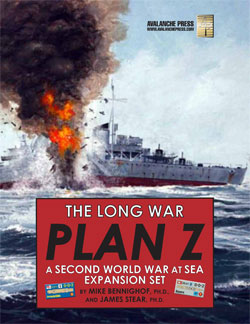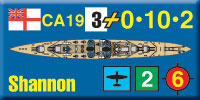| Plan Z:
Winston’s Super Cruisers
By Mike Bennighof, Ph.D.
August 2021
 On 3 September 1939, the United Kingdom declared war on Nazi Germany. Prime Minister Neville Chamberlain immediately re-shuffled his cabinet to put the government on a war footing, moving Earl Stanhope from First Lord of the Admiralty to Lord President of the Council with a charge to oversee Britain’s wartime economy. To replace him at the Admiralty, Chamberlain named Winston Churchill. On 3 September 1939, the United Kingdom declared war on Nazi Germany. Prime Minister Neville Chamberlain immediately re-shuffled his cabinet to put the government on a war footing, moving Earl Stanhope from First Lord of the Admiralty to Lord President of the Council with a charge to oversee Britain’s wartime economy. To replace him at the Admiralty, Chamberlain named Winston Churchill.
Churchill set to his new task with both the energy and the loose grasp of political, economic and military realities that marked his entire life. The Royal Navy had great needs both for the new war and for its potential widening against Italy and Japan: many more escort craft to protect Britain’s overseas lifelines, and the refit and repair of existing warships battered by hard service and the heavy seas around Northern Europe.
Churchill recognized this, but also realized that the coming of war voided all previous limits on warship construction enforced by either treaty or budgetary considerations. The Second London Naval Treaty put sharp limits on cruiser construction: 8,000 tons’ maximum displacement, with their main armament having a caliber no greater than 155mm (6.1 inches). A so-called “escalator clause” allowed a rise in maximum displacement to 10,000 tons if non-signatory nations built larger cruisers, but did not allow larger guns.
Britain had not only signed the treaty, but had been its leading proponent, and so had attempted to keep within its limits, resulting in the cramped (and overweight) Fiji class ships with nine six-inch guns. Eleven such ships were laid down in 1938 and 1939, with plans for more such ships built to somewhat improved plans but still within the same parameters.
Those small cruisers did not satisfy Churchill. With all limits removed, he asked the Director of Naval Construction for designs of completely new and large cruisers he termed “heavy cruisers,” labelling previous heavy cruisers as only “medium cruisers” by comparison. There would be two such ships, one a new heavy cruiser to perform long-range missions around the world, the other an even heavier cruiser to pursue and destroy German commerce raiders.
 The new heavy cruiser would displace 15,000 tons, with greatly improved subdivision over previous British cruisers and a main armament of nine 8-inch (203mm) guns. She would be armored against 8-inch shellfire, with much better protection than the old County class “Treaty” cruisers. Churchill specifically noted that he sought a cruiser that would out-match the German Hipper class ships. The new heavy cruiser would displace 15,000 tons, with greatly improved subdivision over previous British cruisers and a main armament of nine 8-inch (203mm) guns. She would be armored against 8-inch shellfire, with much better protection than the old County class “Treaty” cruisers. Churchill specifically noted that he sought a cruiser that would out-match the German Hipper class ships.
Discussions continued after Churchill left the Admiralty to become Prime Minister, as a somewhat smaller variant that offered significant cost savings gained favor. Unable to decide, the Admiralty solicited the views of the various fleet commanders, who pushed for the larger ship but fretted that she carried a rather light armament for her great size. Newly-developed fire control radar could now track 8-inch shells (previous models could only follow larger rounds) which made the cruiser much more attractive and the Sea Lords finally recommended that five of them be laid down toward an eventual goal of 20 such ships. To make up for the cost, two Lion-class battleships would be cancelled.
Orders were placed for new guns but not for the ships. Vickers-Armstrong designed the 8-inch, 50-caliber Mark X intended for these cruisers in the spring of 1941, but no examples were manufactured. On paper at least it was a very fine weapon, much lighter than the Mark VIII guns of previous British heavy cruisers with a new breech mechanism that promised faster loading. It fired a heavier shell than the Mark VIII – already a very good gun – at slightly greater range.
Further studies continued until June 1943, with the ship growing to 17,500 tons as more electronics and close-range anti-aircraft guns, and crew space for the necessary personnel, were added to the design. The order for new guns was cancelled in July 1942, and finally in June 1943 the Sea Lords ruled that there would be no new large cruisers built of any type.
 Churchill’s other fantasy ship had far less support in the Admiralty: a 22,000-ton cruiser with the same high speed as the new heavy cruiser (33.5 knots) and an armament of a dozen 9.2-inch guns. While Churchill’s dilettante interference in matters of which he knew little at times entered the realms of the stupid or the insane, the concept had been around for a while: a “Treaty Cruiser killer,” a ship designed to catch and destroy the many heavy cruisers built under the restrictions of the 1922 Washington Naval Limitations Treaty (10,000 tons’ displacement and a maximum armament of 8-inch guns). Churchill’s other fantasy ship had far less support in the Admiralty: a 22,000-ton cruiser with the same high speed as the new heavy cruiser (33.5 knots) and an armament of a dozen 9.2-inch guns. While Churchill’s dilettante interference in matters of which he knew little at times entered the realms of the stupid or the insane, the concept had been around for a while: a “Treaty Cruiser killer,” a ship designed to catch and destroy the many heavy cruisers built under the restrictions of the 1922 Washington Naval Limitations Treaty (10,000 tons’ displacement and a maximum armament of 8-inch guns).
Churchill may have intended his huge cruiser to run down and sink the so-called “pocket battleships” that were loose on the high seas at the time the First Lord made his request. No 9.2-inch gun was in production or even designed at the time; the gun probably would have been either a scaled-up version of the 8-inch Mark X or a scaled-down version of the 12-inch Mark XIV, an experimental all-steel weapon that was the basis of the very good main guns of the King George V and Lion class battleships.
Despite either fine pedigree, this hypothetical gun would have been seriously out-ranged by the 11-inch (280mm) guns of the German armored cruisers, and the British ship would have needed to use her speed advantage to close the range where her greater number of barrels could overwhelm the German ship with her greater volume of fire. But the new heavy cruiser could have done the same, at significantly less cost per ship.

HMS Exeter after fighting the German armored cruiser Graf Spee.
The new super-cruiser would have been useful in the Far East to counter the big Japanese A-type heavy cruisers armed with ten 8-inch guns. The new heavy cruiser would have been a somewhat better ship than the Japanese vessels, but not nearly as superior as the bigger cruiser.
No foreign ship carried a weapon of similar caliber, though some studied super-cruisers of their own, notably the Soviets and Americans. Nevertheless, the Director of Naval Construction, Stanley V. Goodall, followed standard practice – that a warship’s protection should be proof against her own main armament – and produced a sketch version of the cruiser armored against 9.2-inch shellfire. That made for a very well-armored heavy cruiser, with significant deck protection (an unusual feature) indicating that she was intended to fight at long ranges.
Unlike the 8-inch cruiser design, the super-cruiser project did not survive Churchill’s brief tenure at the Admiralty. The Sea Lords had already voiced their opposition, pointing out that for the cost of the three super-cruisers proposed by Churchill, two additional fast battleships of the Vanguard class could be built and, as an existing design built around an existing weapon, could be completed almost a year earlier. When Churchill left the Admiralty in May 1940 to take up the post of Prime Minister, the project was dropped along with his project for a small, heavily-armored cruiser armed only with submerged torpedo tubes.
The super-cruiser proposal was no sillier than some of the ships projected for the German Plan Z, and so she appears (all three proposed ships) in our Second World War at Sea: Plan Z expansion set. She’s a mighty ship, especially so with a British crew, and represents a fair amount of overkill when matched against a German heavy cruiser.
Click here to order Second World War at Sea: Plan Z (book edition) right now.
Sign up for our newsletter right here. Your info will never be sold or transferred; we'll just use it to update you on new games and new offers.
Mike Bennighof is president of Avalanche Press and holds a doctorate in history from Emory University. A Fulbright Scholar and NASA Journalist in Space finalist, he has a whole passel of books, games and articles on historical subjects.
He lives in Birmingham, Alabama with his wife, three children and his dog, Leopold. Leopold despises motorcycles.
|
